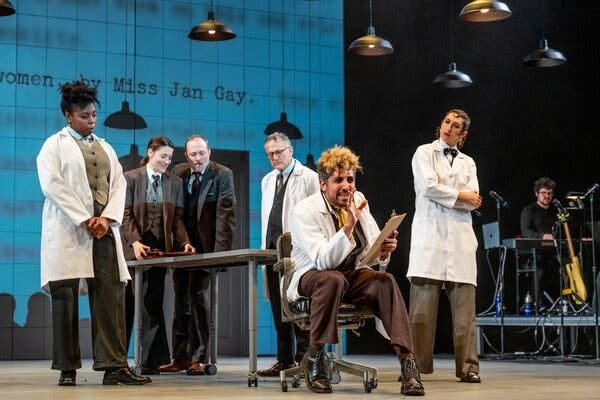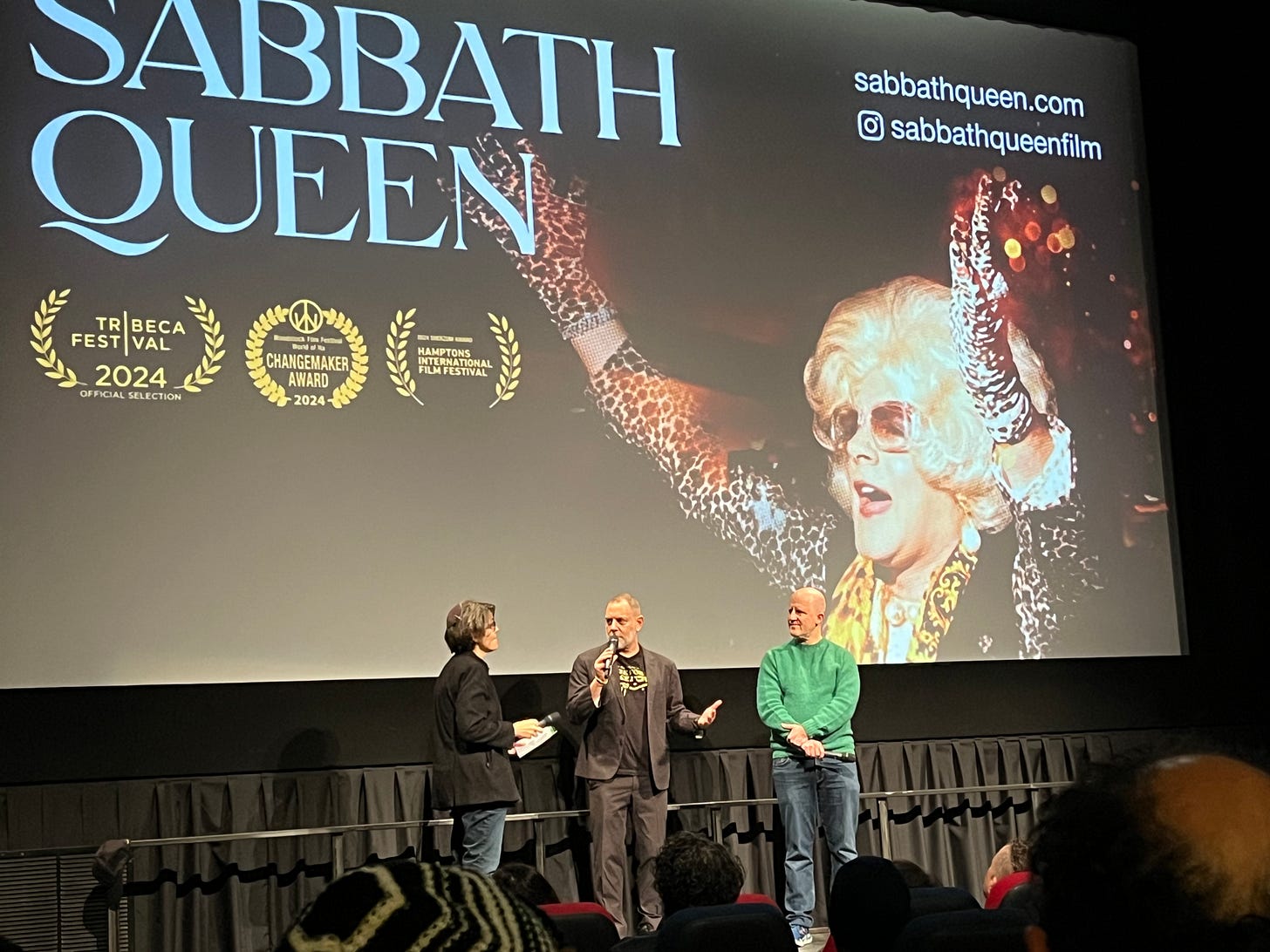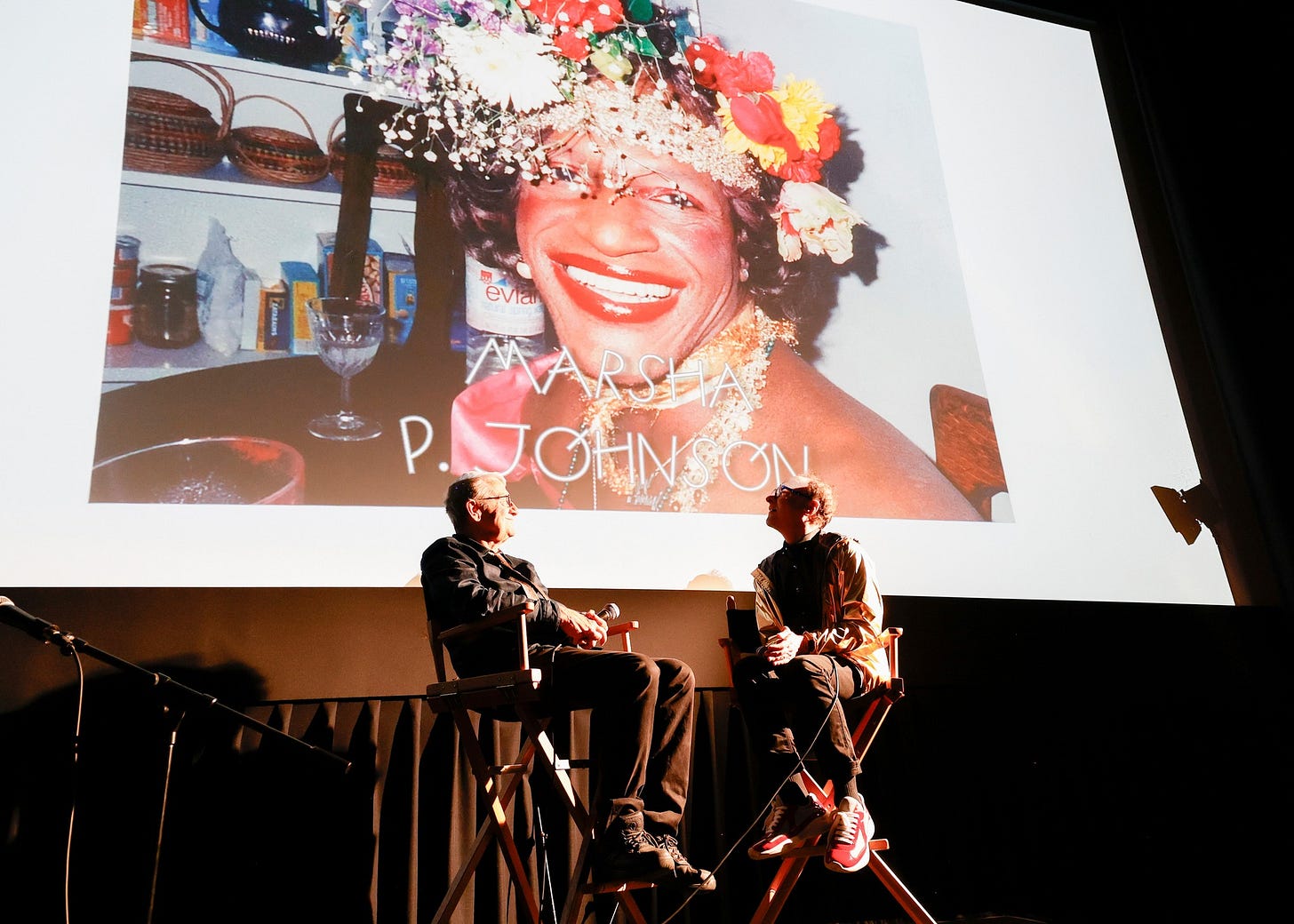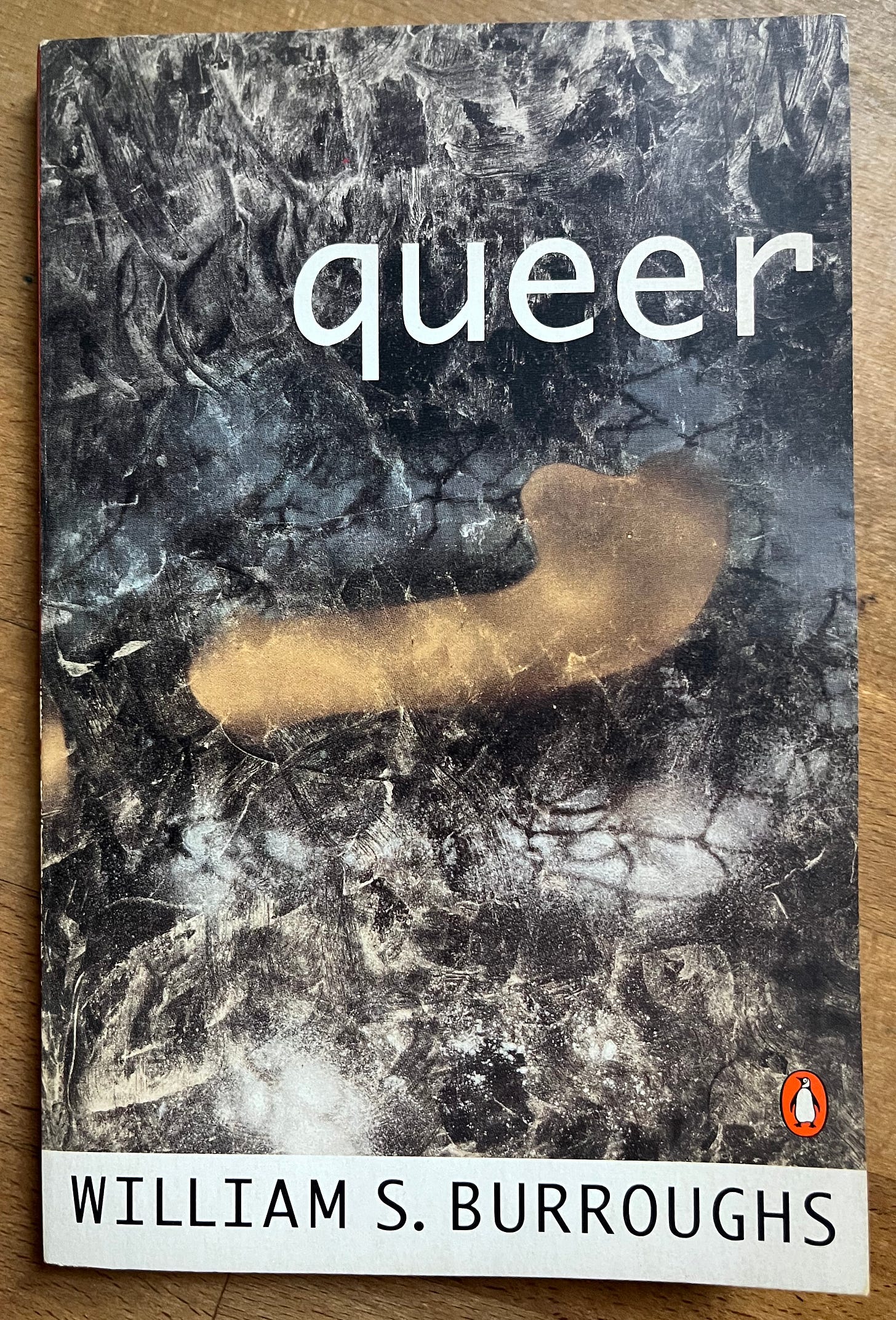Culture Vulture: SABBATH QUEEN, QUEER, TRANSA, and more
Sun Dogs (at Brooklyn Academy of Music’s Next Wave November 18 & 19) was billed as a series of collaborations between filmmakers and composers, including two of my favorites – Thai director Apichatpong Weerasethakul (below) and Pakistani-American singer-composer Arooj Aftab. The actual event was underwhelming. The visual component was minimal (the other filmmakers were Josephine Decker and Mati Diop with Manon Lutanie), and neither Aftab nor Devonté Hynes (aka Blood Orange, another singer-composer I admire) performed live. It was essentially a concert by Alarm Will Sound, a well-regarded contemporary music ensemble I probably wouldn’t have gone out of my way to see. Once I let go of my expectations, I appreciated making the acquaintance of Alarm Will Sound, whose performance (conducted by Alan Pierson) was lovely.
Weerasethakul’s idiosyncratic films, which occupy a curious territory somewhere between dreamscape and documentary while in service to an often-oblique fictional narrative, are not readily available on streaming platforms, but three of the most acclaimed – Uncle Boonmee Who Can Recall His Past Lives, Cemetery of Splendour, and Tropical Malady – are currently viewable for Metrograph members on the cinema’s website.
*
The Civilians is a New York-based company, led by Steve Cosson, that works in an idiom sometimes referred to as Theater of Testimony – cf. Tectonic Theater Company (The Laramie Project), Anna Deveare Smith (Fires in the Mirror, Twilight: Los Angeles, 1992), Emily Mann (Execution of Justice), etc. Ten years in the making, the company’s latest piece of “investigative theater,” “Sex Variants of 1941: A Study of Homosexual Patterns,” explores both the contents and the creation of the book by the same name. The author, psychiatrist George W. Henry, capitalized on the first-hand work of two queer researchers: Thomas Painter, who focused on male sex workers, and Jane Gay (the pseudonym for Helen Reitman), who conducted interviews with over 300 lesbians in the United States and Europe. In a fleet 75-minute performance at NYU’s Skirball Center, Sex Variants introduces the various authors and a dozen or so of the subjects they studied, their erotic practices, their slang (browning! pedication!), and the various ways they dealt with the dance between non-judgmental anthropology and pathologizing medical treatment. The piece was written and directed by Cosson in collaboration with James la Bella and Jessica Mitrani.
An excellent ensemble of six performers – downtown luminaries David Greenspan and Jo Lampert joined Whitney Andrews, Robert M. Johanson, Irene Sofia Lucio, and Heath Saunders – took on numerous roles while also undertaking half a dozen song-and-dance routines to music by Stephen Trask (Hedwig and the Angry Inch), Martha Redbone, Aaron Whitby, and the late great Michael Friedman (a core member of The Civilians). I went with an excited posse of eight friends, and we all felt the show was entertaining but slight. I almost always feel this way about Civilians productions: it could have gone deeper into individual stories, and the musical numbers seem designed to make “difficult” material more appealing to the audience but wind up feeling superfluous, if not trivializing. Discussing the show over dinner down the street at 3 Giovani, two of our group pointed out that Jane Gay also figures heavily in Justin Torres’s recent novel Blackouts.
*
It took a while for me to realize that the new Broadway musical Swept Away at the Longacre Theatre is not based on the 1974 Lina Wertmüller film but rather on a 2004 concept album by the pop-folk trio the Avett Brothers, Mignonette, loosely based on the true story of a whaling ship’s final voyage in 1888. I had no previous file on the Avett Brothers, though I was aware their Americana-flavored music has a substantial following. Michael Mayer directed the show and cast two of his previous leading men – John Gallagher, Jr. from Spring Awakening and Stark Sands from American Idiot – in the main roles alongside Adrian Blake Enscoe and Wayne Duvall. I liked it fine, though the Christian parable got a little heavy-handed for my taste. Andy liked it better.
The performance we saw had a little extra drama. Just as the story headed into its most intense chapter – the ship has gone down and the survivors thrash around in a lifeboat – a woman sitting near us at the back of the orchestra became ill, making sounds somewhere between choking and vomiting. A cry went up, the show paused, the house lights came on, and the woman was laid out in the aisle, where she was attended to by a doctor and a nurse who happened to be sitting nearby, as well as a very skillful house manager. Within ten minutes or so, it was determined that the woman was breathing and conscious, and she was able to get to her feet and walk the few steps to the theater lobby. Meanwhile, a stage manager with headset had slipped onstage to confer with Gallagher, who knew exactly where to re-start the performance. It turned out he was just about to launch into his major monologue. You can imagine the adrenaline that must have been pumping through the actors onstage. Indeed, the show did go on! But I’m sure the audience will never forget the unscheduled interruption.
At the IFC Center, we saw Sabbath Queen, Sandi Dubowski’s powerful documentary about Amichai Lau-Lavie, the Israeli-born 38th generation rabbi who has forged his own path as a queer feminist leader of Lab/Shul, an artist-driven everybody-friendly God-optional congregation in New York City. Twenty-one years in the making, the film steers directly into the numerous conflicts Lau-Lavie has encountered within his family of origin, the rabbinate, and Israeli-Jewish culture over his sexuality, his support for interfaith marriages, and his critique of the destruction of Gaza. Dubowski does an extraordinary job of distilling the story of Jews in the 20th century, including the harrowing story of Amichai’s grandfather’s detention and release from Buchenwald. With an unbelievably light touch, the film manages to touch on Amichai’s principled critique of Jewish patriarchy (“Not every tradition deserves to be passed on”) and the Israeli military’s devastation of Gaza while retaining his commitment to his faith and the belief that his people deserve a home in Zion but only as much as the Palestinian people deserve the same.
Telling the truth takes time, patience, care, intelligence, and courage, as the film demonstrates (both Sandi's work as documentarian and Amichai's as rabbi and activist). I found it extremely moving to witness Amichai’s strength and vulnerability and honesty and moral leadership. A moment in the film has stuck with me profoundly. Contemplating being accountable to his Creator at the end of his life, one part of him imagines a God who would say “Why didn’t you follow the rules?” while another part of him imagines being asked “Why didn’t you follow your heart?”
As he did with Trembling Before G-d, his film about queer Orthodox Jews, Dubowski has arranged talkbacks that transform screenings into opportunities for community dialogue. The director and his subject were joined by Rabbi Rachel Timoner for a lively and substantial Q&A after the show; there are more scheduled this week, as the run at IFC Center has been extended. Asked about the complexity and contradictions of Amichai’s navigating his participation in Radical Faerie gatherings AND rabbinical school AND raising three children with a female couple, Dubowski characterized his journey and his identity as “kaleidoscopic,” which struck me as the perfect description.
*
As long as I’ve known him (almost 50 years now!), Steven Watson has been tireless in his mission as an independent scholar to document cutting-edge American artists of the past century, not as singular creative geniuses but as products of intertwined and interdependent social circles. He has published volume after volume of meticulously researched group histories of the Harlem Renaissance, the Beat Generation, and Andy Warhol’s Silver Factory, among others. With an increasingly ambitious agenda, he has collected artwork, ephemera, memorabilia, audio, and video of artists with whom he has conducted first-hand interviews. Now, with the assistance of a hardy band of younger tech-savvy associates, he has created Artifacts, an online video platform featuring archival interviews with key figures in avant-garde art and queer culture.
The launch party November 25 at Anthology Film Archives was an exciting event. The audience was thick with downtown legends. The program began with Watson being interviewed by the super-smart and snazzily dressed author Wayne Koestenbaum, who beautifully named Watson’s “grandeur of vision” and his “finesse of execution.” Steven talked about how his work as a psychotherapist focused on helping people describe themselves, a skill that served him well in making artists feel safe to share their stories. The Artifacts project of “historical preservation” began, apparently, with Watson’s exposure to the rowdy queer theater troupe Hot Peaches (co-founder Jimmy Camicia was in the audience).
Watson has come a long way since his first publication, the handmade Minette: Recollections of a part-time lady. He showed four sizzle reels covering the major categories featured on the Artifacts website: the Silver Factory (Warhol folks), Gender Benders (Marsha P. Johnson, Quentin Crisp), Underground Press, and Downtown Performers. The last category is still getting up to speed online; I can’t wait to view the interviews with JoAnne Akalaitis, Richard Foreman, and David Greenspan, among others.

*
Red, Hot + Blue, the fantastic compilation of Cole Porter covers by great contemporary pop and rock singers, was the first in a long series of superbly curated anthologies that have raised more than $10 million for HIV/AIDS relief and awareness around the world. The 24th collection just came out, and it’s a doozy. Transa includes 46 songs and contributions from over 100 musicians to celebrate the trans community and to bring awareness to trans rights. It’s the most ambitious Red Hot + project so far, available on streaming platforms and as a deluxe 6-LP boxed set (apparently we’ve definitively reached the time when compact discs have become a thing of the past). There’s also one-disc album of selections you can buy on vinyl. It’s organized in eight chapters: Womb of the Soul, Survival, Dark Night, Awakening, Grief, Acceptance, Liberation, and Reinvention. The performers range from emerging singers I’ve never heard of to big stars (most notably Sade, who contributes “Young Lion,” a tribute to her trans child).
Of course the quality varies across such a gigantic set, but I’ve spent some very happy hours stoned under the headphones savoring any number of treasures. The trans context brings fresh meaning to familiar songs (Sharon Van Etten singing Sinead O’Connor’s “Feel So Different” with Ezra Furman, Bill Callahan and Hand Habits doing Kate Bush’s “Deeper Understanding”). Moses Sumney shows up a couple of times, including a sizzling rearrangement of Sylvester’s “You Make Me Feel (Mighty Real).” André 3000 generously throws in his 26-minute bonkers jazz-ambient track “Something Is Happening And I May Not Fully Understand But I’m Happy to Stand For The Understanding” (in the vein of his Grammy-nominated New Blue Sun album, and with a title that speaks for trans allies everywhere).
Some of the best stuff is saved for last: Wendy & Lisa backing up Lauren Auder on Prince’s “I Would Die 4 U” (“I’m not a woman/I’m not a man/I am something that you’ll never understand”). It’s not all wifty-drifty folkie love-pop. I love the version of Jayne County’s headbanger “Surrender Your Gender” by Laura Jane Grace (“Surrender your gender/Return to sender”). Fittingly, the whole shebang (theybang?) ends with Sam Smith doing a duet with Beverly Glenn-Copeland on his “Ever New.”
I’m always interested to see what Luca Guadagnino is up to as a filmmaker. He set the bar pretty high for himself adapting William S. Burroughs’ novella Queer for the screen. Queer isn’t any kind of literary classic. Originally written in 1952 while Burroughs awaited trial in Mexico City for the accidental fatal shooting of his wife Joan, it was considered unfinished and unpublishable until it finally did come out in 1985 as a 134-page paperback. But it is an unmistakably autobiographical narrative by someone who became a literary legend and punk icon. So it’s almost impossible not to approach the movie thinking, “Hey, James Bond…I mean, Daniel Craig is playing William Burroughs!”
It’s not a biopic, though. Guadagnino’s film is more like one of those radical adaptations of a minor Shakespeare play – you can see the bones of the original, but the adaptor has taken a lot of liberties in order to shape the material to tell the story he wants to tell. Which in this case has to do with a man’s tortured longing for intimate contact with another man – an almost universal sentiment for homosexuals in the 1950s, but alive and well these days for down-low gents and closeted bisexuals, despite the freedom and openness that many queers enjoy. It’s a theme that threads directly or indirectly throughout many of Guadagnino’s films, so we have to assume it has some personal resonance for him.
His Queer takes place not in the gritty “Shitville” of Burroughs’ text but in a stylized cinematic bubble devised to make room for the romantic dreams and drink-and-drug-addled visions that inhabit the consciousness of Craig’s character, William Lee. It also allows the director and his screenwriter, Justin Kuritzkes, to interpolate scenes, images, and events from Burroughs’ life not depicted in the novella. For instance, in the book Lee and Gene Allerton, the young man with whom he’s conducting an ambivalent love affair with, travel to Ecuador in search of yage, aka ayahuasca, but never find it. In the film they do have a ceremony conducted by Dr. Cotter, a grizzled ethnobotanist (a man in the book, a woman in the film). It’s not an accurate depiction of an ayahuasca journey, but that’s not the point. Lee is fixated on this drug because he’s heard that it gives users the power of telepathy. And his interest in telepathy is hilariously basic: he wants to be able to tell who’s queer and who’s not without asking, to be able to say “I love you so much” without speaking — again, not an unusual sentiment among guys who are doing their damnedest to disguise their own queerness. It’s a dark film with a sentimental streak to it. I enjoyed the surreal touches, and I was shocked afterwards to realize that was Jason Schwartzman hiding inside a fat suit playing a fictional version of Allen Ginsberg and that grimy gringo bruja in the jungle was Lesley Manville.
If you are enjoying these posts, please consider becoming a subscriber. All eyes are welcome, and I especially appreciate paid subscriptions. They don’t cost much — $5/month, $50/year — but they encourage me to continue sharing words and images that are meaningful to me. If it helps, think of a paid subscription as a tip jar: not mandatory but a show of appreciation.











